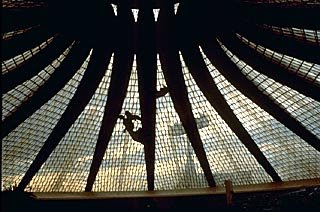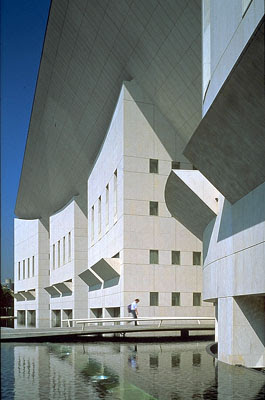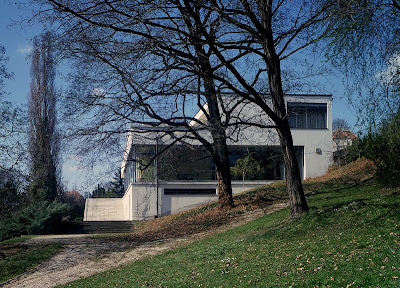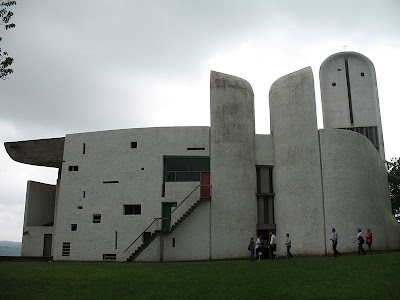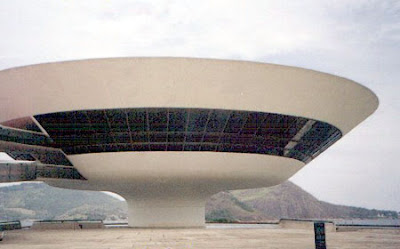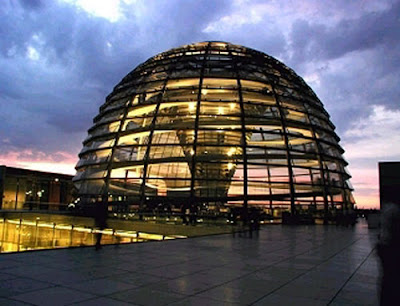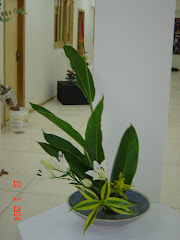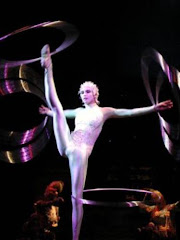sábado, 22 de novembro de 2008
Santiago Calatrava Architect and Engineer
(b. Valencia, Spain 1951)
Santiago Calatrava was born in Valencia, Spain in 1951. He graduated from the Institute of Architecture in Valencia and from the Federal Institute of Technology in Zurich. Calatrava opened his own architecture and engineering office in Zurich. Most of his early realized work was in Switzerland and Spain, where he has exhibited his designs and won several awards.
As both an architect and an engineer, Calatrava easily identifies with both disciplines. He often creates innovative works that depend on a firm grasp of both the creative and structural aspects of design. His skills as an engineer allow him to create sculptural surfaces and unusual spaces.
Calatrava avoids the apathetic acceptance of established forms. In 1979 he won the Auguste Perret award for rekindling the quality of Perret's structural work and for re-emphasizing the importance of primary structure in defining form.
Despite an influential presence within the European architectural community, Calatrava has rarely designed a totally enclosed building. Rather, most of his creations are open structures.
References
Peter Cook and Rosie Llewellyn-Jones. New Spirit in Architecture. New York: Rizzoli International, 1991. ISBN 0-8478-1263-4. NA680.C65.
sexta-feira, 24 de outubro de 2008
Oscar Niemeyer Pritzker Architecture Prize Laureates 1988
Oscar Niemeyer was born in the hillside district of Rio de Janeiro, Brazil and has lived and worked in that area ever since, with occasional forays to France and Italy.
As a student working in the office of Lucio Costa, a prominent architect, he was assigned to work on the plans of the Ministry of Public Instruction designed by the famous French architect Le Corbusier.
It was while working on this project that he met the mayor of Brazil's wealthiest central state, Juscelino Kubitschek, who would later become President of Brazil. As President, he appointed Niemeyer to be the chief architect of Brasilia, a project which occupied all of his time for many years.
Among his other world projects, he collaborated with Le Corbusier again on the design for the United Nations Headquarters in New York. His own residence in Rio de Janeiro has become a landmark. In the 1950's, he designed an Aeronautical Research Center near Sao Paulo. In Europe, he did an office building for Renault and the Communist Party Headquarters both in Paris, a cultural centre for Le Havre, and in Italy, the Mondadori Editorial Office in Milan and the FATA Office Building in Turin. In Algiers, he designed the Zoological Gardens, the University of Constantine, and the Foreign Office.
Although semi-retired, he still works at the drawing board and welcomes young architects from all over the world. He hopes to instill in them the sensitivity to aesthetics that allowed him to strive for beauty in the manipulation of architectural forms.
"I have always," says Niemeyer, "accepted and respected all other schools of architecture, from the chill and elemental structures of Mies van der Rohe to the imagination and delirium of Gaudi. I must design what pleases me in a way that is naturally linked to my roots and the country of my origin.
"As an architect," he continues, "my concern in Brasilia was to find a structural solution that would characterize the city's architecture. So I did my very best in the structures, trying to make them different with their columns narrow, so narrow that the palaces would seem to barely touch the ground. And I set them apart from the facades, creating an empty space through which, as I bent over my work table, I could see myself walking, imagining their forms and the different resulting points of view they would provoke.
"When I started to design the Museum of Modern Art for Niteroi, I already had an idea in mind. An abstract circular form above the landscape, and the site free of other constructions to better emphasize the building.
"I did not want to repeat the usual solutions of a cylinder above another, but to move in the direction of the design for the Caracas Museum, creating a line which would rise with curves and straight lines from the ground up to the roof.
"The exhibition hall would be surrounded by straight walls —I did not want it glazed — but with exits for the external gallery which would encircle it, integrating it in the magnificent panorama.
"As it often happens this solution calling for a central support sustaining only the exhibition room was modified. With the addition of one meter in height on the radial beams, measuring one meter and a half, we would add a new floor, including the 'foyer,' the reception room, the auditorium, work rooms, library and bathrooms. This would result in a more complete and economical project.
"My architecture followed the old examples. The beauty prevailing over the limitations of the constructive logic. My work proceeded, indifferent to the unavoidable criticism set forth by those who take the trouble to examine the minimum details, so very true of what mediocrity is capable of.
"It was enough to think of Le Corbusier saying to me once while standing on the ramp of the Congress: `There is invention here'."
domingo, 21 de setembro de 2008
St. Peter's Basilica - Vatican City
The Basilica of Saint Peter (Latin: Basilica Sancti Petri), officially known in Italian as the Basilica di San Pietro in Vaticano and commonly known as St. Peter's Basilica, is located within the Vatican City. It occupies a "unique position" as one of the holiest sites and as "the greatest of all churches of Christendom".[1][2][3] In Catholic tradition, it is the burial site of its namesake Saint Peter, who was one of the twelve apostles of Jesus and, according to tradition, was the first Bishop of Antioch, and later first Bishop of Rome and therefore first in the line of the papal succession. While St. Peter's is the most famous of Rome's many churches, it is not the first in rank, an honour held by the Pope's cathedral church, the Basilica of St. John Lateran. (See: Status)
Catholic tradition holds that Saint Peter's tomb is below the altar of the basilica. For this reason, many Popes, starting with the first ones, have been buried there. There has been a church on this site since the 4th century. Construction on the present basilica, over the old Constantinian basilica, began on April 18, 1506 and was completed in 1626.[4]
St. Peter's is famous as a place of pilgrimage, for its liturgical functions and for its historical associations. It is associated with the papacy, with the Counter-reformation and with numerous artists, most significantly Michelangelo. As a work of architecture, it is regarded as the greatest building of its age.[5] Contrary to popular misconception, Saint Peter's is not a cathedral, as it is not the seat of a bishop. It is properly termed a basilica. Like all the earliest churches in Rome,[6] it has the entrance to the east and the apse at the west end of the building.
Michelangelo redesigned the dome, taking into account all that had gone before. His dome, like that of Florence, is constructed of two shells of brick, the outer one having 16 stone ribs, twice the number at Florence but far fewer than in Sangallo's design. As with the designs of Bramante and Sangallo, the dome is raised from the piers on a drum. The encircling peristyle of Bramante and the arcade of Sangallo are reduced to 16 pairs of Corinthian columns, each of 15 metres (50 ft) high which stand proud of the building, connected by an arch. Visually they appear to buttress each of the ribs, but structurally they are probably quite redundant. The reason for this is that the dome is ovoid in shape, rising steeply as does the dome of Florence Cathedral, and therefore exerting less outward thrust than does a hemispherical dome, such as that of the Pantheon, which, although it is not buttressed, is countered by the downward thrust of heavy masonry which extends above the circling wall.[5][19]
The ovoid profile of the dome has been the subject of much speculation and scholarship over the past century. Michelangelo died in 1564, leaving the drum of the dome complete, and Bramante's piers much bulkier than originally designed, each 18 metres (59 ft) across. On his death the work continued under his assistant Vignola with Giorgio Vasari appointed by Pope Pius V as a watchdog to make sure that Michelangelo's plans were carried out exactly. Despite Vignola's knowledge of Michelangelo's intentions, little happened in this period. In 1585 the energetic Pope Sixtus appointed Giacomo della Porta who was to be assisted by Domenico Fontana. The five year reign of Sixtus was to see the building advance at a great rate.[19]
Giacomo della Porta and Fontana brought the dome to a completion in 1590, the last year of the reign of Sixtus V. His successor, Gregory XIV, saw Fontana complete the lantern and had an inscription to the honour of Sixtus V placed around its inner opening. The next pope, Clement III, had the cross raised into place, an event which took all day, and was accompanied by the ringing of the bells of all the city's churches. In the arms of the cross are set two lead caskets, one containing a fragment of the True Cross and a relic of St. Andrew and the other containing medallions of the Holy Lamb.[19]
In the mid-18th century, cracks appeared in the dome, so four iron chains were installed between the two shells to bind it, like the rings that keep a barrel from bursting. As many as ten chains have been installed at various times, the earliest possibly planned by Michelangelo himself as a precaution, as Brunelleschi did at Florence Cathedral.
Around the inside of the dome is written, in letters 2 metres (6.5 ft) high:
fonte wikipédia
sexta-feira, 29 de agosto de 2008
Peter Cook (architect)
Sir Peter Cook (born in 1936 in Southend, Essex) is a notable English architect, teacher and writer about architecture.
From 1953 to 1958, he studied architecture at Bournemouth College of Art, and then moved to the Architectural Association School of Architecture in London, graduating in 1960. He later returned to the AA as a teacher.
While working in the office of James Cubitt & Partners, Cook was one of the founder members of the influential Archigram group in the 1960s. In 1969 he received a grant from the Graham Foundation for work done with Archigram.
He was Director of the Institute of Contemporary Arts in London, from 1970 to 1972.
He was appointed Life Professor at the Staedelschule (Art Academy) of Frankfurt in 1984, helping establish its reputation as one of the leading German architecture schools.
He later (1990) became Professor of Architecture at The Bartlett School of Architecture, University College London, a position from which he retired in 2005.
In 2002, Royal Institute of British Architects awarded Archigram the Royal Gold Medal for architecture. In 2004, he was shortlisted for the Stirling Prize with Colin Fournier for the Kunsthaus Graz. In 2007, he was made a Knight Bachelor in the Queen's birthday honours.
The Kunsthaus Graz, Grazer Kunsthaus, or Graz Art Museum was built as part of the European Capital of Culture celebrations in 2003 and has since become an architectural landmark in Graz, Austria. Its exhibition program specializes in contemporary art of the last four decades.
Its unusual form differs radically from conventional exhibition contexts, many of which maintain the traditions of the modernist "White Cube". The team of architects used an innovative stylistic idiom, known as blob architecture within the historical ambiance of the Murvorstadt. Thus, the gigantic building affectionately called the "Friendly Alien" by its creators Peter Cook and Colin Fournier, in form and material, stands out consciously against the surrounding baroque roof landscape with its red clay roofing tiles but nevertheless integrates the façade of the 1847 iron house.
Concept
Architecture, Design, new media, InterNet art, film, photography. Art in all its manifestations are united under one roof. The Graz Art Museum was developed as an institution to stage international exhibitions of multidisciplinary, modern and contemporary art from the 1960s to the present day. It doesn't collect, maintains no permanent exhibitions, has no permanent depot at its disposal and no research establishments. Its exclusive purpose it to present and procure contemporary art productions. The Graz Art Museum implements an innovative concept, which offers various possibilities in its galleries to fulfill the high curatorial requirements of contemporary exhibitions.
fonte wikipédia
domingo, 24 de agosto de 2008
Paulo Mendes da Rocha (born 1928) is a Brazilian architect- 2006 Pritzker Prize
For your information The Pritzker Architecture Prize, award for excellence in architecture, given annually since 1979.
The Brazilian Museum of Sculpture sets on a 75,000-square foot triangular site on a main thoroughfare in São Paulo, Brazil. Instead of creating a free-standing building, architect Paulo Mendes da Rocha treated the museum and the landscape are treated as a whole.
Large concrete slabs create partly underground internal spaces and also form an exterior plaza with water pools and an esplanade. An emmense 97-foot long, 39-foot wide beam frames the museum.
fonte architecture.about.com
sábado, 16 de agosto de 2008
Jean Nouvel-Pritzker Prize in 2008
Jean Nouvel (born 12 August 1945) is a French architect. Nouvel studied at the École des Beaux-Arts in Paris and was a founding member of Mars 1976 and Syndicat de l'Architecture. He has obtained a number of prestigious distinctions over the course of his career, including the Aga Khan Award for Architecture (technically, the prize was awarded for the Institut du Monde Arabe which Nouvel designed), the Wolf Prize in Arts in 2005 and the Pritzker Prize in 2008. A number of museums and architectural centres have presented retrospectives of his work.
Nouvel was awarded the Pritzker Prize, architecture's highest honor, in 2008, for his work on more than 200 projects,among them, in the words of The New York Times, the "exotically louvered" Arab World Institute, the bullet-shaped and "candy-colored" Torre Agbar in Barcelona, the "muscular" Guthrie Theater with its cantilevered bridge in Minneapolis, and in Paris, the "defiant, mysterious and wildly eccentric" Musée du quai Branly (2006) and the Philharmonie de Paris (a "trip into the unknown" c. 2012).[3][8]
Pritzker points to several more major works: in Europe, the Cartier Foundation for Contemporary Art (1994), the Culture and Convention Center (KKL, 2000) in Lucerne, the Opéra Nouvel (2003) in Lyon, Expo 2002 in Switzerland and, under construction, the Copenhagen Concert Hall and the courthouse in Nantes (2000); and two tall towers in planning in North America, Tour Verre in New York City and SunCal in Los Angeles.
In its citation, the jury of the Pritzker prize noted:
Of the many phrases that might be used to describe the career of architect Jean Nouvel, foremost are those that emphasize his courageous pursuit of new ideas and his challenge of accepted norms in order to stretch the boundaries of the field. [...] The jury acknowledged the ‘persistence, imagination, exuberance, and, above all, an insatiable urge for creative experimentation’ as qualities abundant in Nouvel’s work.
Nouvel is the second French citizen to win the Pritzker Prize, after Christian de Portzamparc in 1994.
fonte: wikipédiaquinta-feira, 7 de agosto de 2008
Brazilian Architect Eolo Maia
MINERALOGY MUSEUM
Originally conceived as Tourist Support Center, the building known as "Rainha da Sucata" nowadays houses the Minas Gerais' mineralogical permanent exposition. The project was developed to respect the scale and the typology of the buildings at Liberty Square, where it is situated. After approved by Historic Patrimony State Institution, the City Hall considered it as a special piece due to its urban and volumetric purposes that respect the surrounding buildings. The goal of the building is ludic and instructive. Its architecture is an open book from where people can get information about our culture and local materials.
Fonte site oficial eolojo.com.br
domingo, 3 de agosto de 2008
Christian de Portzamparc -1994 Pritzker Architecture Prize Laureate
Christian de Portzamparc will be celebrating his fiftieth birthday on May 5 (1994), an anniversary that will be made even more memorable by the fact that he has just been named the 1994 Pritzker Architecture Prize Laureate. He is the seventeenth person and the sixth European to be so honored since The Hyatt Foundation established the award in 1979.
Highly respected by architectural cognoscente throughout the world, this relatively young French architect explains that he was "a designer who painted before he decided to study architecture." While he still paints, he says, "I am not a painter or sculptor, yet." He is however a frequent lecturer and author. Although he has no built works in the United States, he was one of the finalists in the competition for Chicago's new Museum of Contemporary Art and an Art Museum for Omaha. Most recently he has gained recognition in Japan where he designed apartment buildings for the city of Fukuoka.
Most of his completed projects are in France, perhaps the most visible being the City of Music, a group of structures situated on the edge of the La Villette suburban park in Paris. The project actually has two phases. The first part, housing the National Conservatory of Music and Dance was completed in 1990. The second part with public spaces for concerts will open next January. Portzamparc says when he began work on the City of Music in 1984, his thoughts were carried back to a house in Brittany, the first thing he ever built, "In that design, each room was like a separate little house," he says. "I have discovered that each new project is the sum of all my previous works. No new work springs to life without some relationship to past inspiration."
fonte www.pritzkerprize.comsexta-feira, 1 de agosto de 2008
Architect Jørn Utzon / Sydney Opera House
Utzon was born in Copenhagen as the son of a naval engineer, and grew up in Denmark. From 1937 he studied architecture at the University of Copenhagen and worked for Alvar Aalto and Frank Lloyd Wright. He started his own office in 1950 in Copenhagen. In 1957 he unexpectedly won the competition to design the Sydney Opera House, despite the fact that it was his first non-domestic design and his entry did not meet the contest criteria; the designs he submitted were little more than preliminary drawings. One of the judges, Eero Saarinen, described it as "genius" and declared he could not endorse any other choice. In contrast, Ludwig Mies van der Rohe turned his back when introduced to Utzon.
The Sydney Opera House is located in Sydney, New South Wales, Australia. Based on the competition winning entry by Danish architect Jørn Utzon, the Sydney Opera House is one of the world's most distinctive 20th century buildings, and one of the most famous performing arts venues in the world.
fonte wikipedia / about com architecture
quinta-feira, 31 de julho de 2008
The Bauhaus school was founded by Walter Gropius in Weimar
The Bauhaus school was founded by Walter Gropius in Weimar. In spite of its name, and the fact that its founder was an architect, the Bauhaus did not have an architecture department during the first years of its existence. The Bauhaus style became one of the most influential currents in Modernist architecture and modern design. The Bauhaus had a profound influence upon subsequent developments in art, architecture, graphic design, interior design, industrial design and typography.
The school existed in three German cities (Weimar from 1919 to 1925, Dessau from 1925 to 1932 and Berlin from 1932 to 1933), under three different architect-directors: Walter Gropius from 1919 to 1927, Hannes Meyer from 1927 to 1930 and Ludwig Mies van der Rohe from 1930 to 1933, when the school was closed by the Nazi regime.
The changes of venue and leadership resulted in a constant shifting of focus, technique, instructors, and politics. When the school moved from Weimar to Dessau, for instance, although it had been an important revenue source, the pottery shop was discontinued. When Mies van der Rohe took over the school in 1930, he transformed it into a private school. wikipédiaquarta-feira, 30 de julho de 2008
Architect Richard Rogers
(b. Florence, Italy 1933)
Richard Rogers was born in Florence, Italy in 1933. He attended the Architectural Association School in London before graduating from Yale University. He and his first wife, Sue, worked in a partnership with Norman and Wendy Foster as "Team 4". In contrast to Foster, who generated a sophisticated architecture based in technology, Rogers created lavish, enthusiastic designs. In 1970 Rogers established a partnership with the Italian architect Renzo Piano. After the completion of the Pompidou Center in Paris, the Richard Rogers Partnership was formed.
His works reject the classical past, while enthusiastically embracing a technological future with its accompanying aesthetic. Although he places emphasis on technology, he believes that it cannot be an end in itself, but must attempt to solve existing social and ecological problems.
His interest in uninterrupted interior spaces has made Rogers an heir to the functionalist tradition. His concern with total flexibility and obvious technical imagery has been termed Late Modern. However, his more recent works have returned to the images of the early Modernists, notably Mendelsohn.
References
Dennis Sharp. The Illustrated Encyclopedia of Architects and Architecture.Architect Ludwig Mies van der Rohe
(b. Aachen, Germany 1886; d. Chicago, Illinois 1969)
Ludwig Mies Van der Rohe was born in Aachen, Germany in 1886. He worked in the family stone-carving business before he joined the office of Bruno Paul in Berlin. He entered the studio of Peter Behrens in 1908 and remained until 1912.
Under Behrens' influence, Mies developed a design approach based on advanced structural techniques and Prussian Classicism. He also developed a sympathy for the aesthetic credos of both Russian Constructivism and the Dutch De Stijl group. He borrowed from the post and lintel construction of Karl Friedrich Schinkel for his designs in steel and glass.
Mies worked with the magazine G which started in July 1923. He made major contributions to the architectural philosophies of the late 1920s and 1930s as artistic director of the Werkbund-sponsored Weissenhof project and as Director of the Bauhaus.
Famous for his dictum 'Less is More', Mies attempted to create contemplative, neutral spaces through an architecture based on material honesty and structural integrity. Over the last twenty years of his life, Mies achieved his vision of a monumental 'skin and bone' architecture. His later works provide a fitting denouement to a life dedicated to the idea of a universal, simplified architecture
Mies died in Chicago, Illinois in 1969.
ReferencesDennis Sharp. The Illustrated Encyclopedia of Architects
Le Corbusier - one of the most important architects of the twentieth century.
Age 29 moved to Paris, where he adopted his pseudonym, which borrowed the name of his maternal grandfather. His figure was marked by his dark glasses round of rims. He died by drowning on August 27, 1965.
fonte wikipédia
terça-feira, 29 de julho de 2008
Oscar Niemeyer
Oscar Ribeiro de Almeida Niemeyer Soares Filho (born December 15, 1907, Rio de Janeiro) is a Brazilian architect who is considered one of the most important names in international modern architecture. He was a pioneer in the exploration of the constructive possibilities of reinforced concrete.
His buildings are often characterised by being spacious and exposed, mixing volumes and empty space to create unconventional patterns and often propped up by pilotis. Both lauded and criticised for being a "sculptor of monuments", his most famous design, the plan for the city of Brasilia.wikipédia
segunda-feira, 28 de julho de 2008
Frank Lloyd Wright
During his 70-year career, Frank Lloyd Wright designed 1,141 buildings, including homes, offices, churches, schools, libraries, bridges, and museums. Five hundred and thirty-two of these designs were completed, and 409 still stand.
Frank Lloyd Wright pioneered a long, low style known as the Prairie house. He experimented with obtuse angles and circles, creating unusually shaped structures such as the spiral Guggenheim Museum (1943-49). He developed a series of low-cost homes that he called Usonian. And most importantly, Frank Lloyd Wright changed the way we think of interior space.
Frank Lloyd Wright was married three times and had seven children. His work was controversial and his private life was often the subject of gossip. Although his work was praised in Europe as early as 1910, it was not until 1949 that he received an award from American Institute of Architects.click2architects
About Architecture - Norman Foster
Dieta da Alma
Cada dia cresce mais e mais a preocupação e os cuidados com o corpo. Não faltam dietas,
quer para emagrecer, engordar, manter
o peso, controlar o colesterol, etc.
Todas têm um caminho certo:
Cuidar do organismo através do controle da alimentação para uma vida mais saudável.
Com tanto esforço da dietoterapia e
das academias, seja louvável e necessário, não obstante, eu pergunto:
Quem vai cuidar da alma?
Qual a dieta que elimina as “toxinas” de nosso interior e o excesso de “gordura” de nossas emoções?
Na lógica das dietas alimentares, sem corte de tudo que é prejudicial para o organismo, seja por excesso e/ou
contaminação, não são possíveis saúde
e bem estar.
Partindo dessa lógica, eu gostaria de prescrever uma dieta para a alma,
a base de cortes radicais
que somente serão possíveis através de uma grande força de vontade.
Esta força de vontade
deve emergir da própria alma e será produzida pela certeza de que:
É preciso ser feliz.
Minha dieta está baseada na eliminação de cinco sentimentos que, enquanto estiverem em nós, produzem
uma espécie de “lixo” interior:
orgulho – inveja – amargura
vingança - ódio
Toda pessoa orgulhosa é doente e não se dá conta disso. O ORGULHO, via de regra, conduz ao isolamento social e se fundamenta numa
grande ilusão, de querer ser aquilo que se é.
Todo orgulhoso termina a vida frustrado e só.
Eliminando o orgulho, você libera outros sentimentos que tornarão sua
vida bem melhor.
A INVEJA é sempre um atestado de incompetência, além de ser pobreza de espírito. É também a revelação de um péssimo
caráter. O invejoso tem um sorriso falso, tem uma mente doente e geralmente contamina outras pessoas, destruindo amizades
e relacionamentos.
É bom a gente ver também o sucesso dos outros e ajudá-los em suas conquistas, pois neste mundo de DEUS, há espaço para todos.
O invejoso é um fraco.
Toda pessoa amargurada vive sempre com a alma sangrando por dentro, gotejando lágrimas de um eterno sofrer. A AMARGURA, quando cria raízes no coração, produz o
ressentimento, o desencantamento da vida,
a tristeza contínua que logo é refletida
através de um olhar distante e sem brilho,
pelo sorriso vazio ou pelo coração fechado para o amor. Quantas pessoas há que não conseguem mais sorrir, perderam completamente a alegria de viver! Como é possível viver feliz com amargura no coração ?
Na vida nada é melhor que um dia após o outro. Por isso mesmo evite ser uma pessoa de espírito vingativo, pois a VINGANÇA
é a arma dos fracos, dos que não têm DEUS no coração. A vida dá sempre
muitas voltas e deixe que ela mesma se encarregará de esclarecer muitas coisas e,
por mais difícil que seja, abençoe sempre
os que lhe desejam o mal.
Aprender a abençoar é também aprender
a ser livre.
Por último, não permita jamais que o ÓDIO
se instale dentro de você. Ele é uma espécie de tumor maligno em nossa afetividade e poderá um dia evoluir para um grande
tumor maligno em nosso corpo.
Ele é irracional, prejudicial e desnecessário.
O ódio é sempre a negação do amor e falta
do amor revela a ausência de DEUS.
Quem odeia, não perdoa, e quem não perdoa vive intranqüilo, sem paz e cheio de remorso. O ódio é o câncer da alma!
A vida é um dom de DEUS.
Viver bem é uma necessidade e também um desafio. Cuide de seu corpo,
elimine tudo que lhe faz mal,
...Mas cuide também de sua vida interior
eliminando as “toxinas” e as “gorduras” da alma; elas adoecem as emoções, deformam a estética de nossa interioridade e
produzem muitos males ao longo da vida.
“Finalmente irmãos, tudo o que
é verdadeiro, tudo o que é respeitável,
tudo o que é justo, tudo o que é puro,
tudo o que é amável, tudo o que é de
boa fama, se alguma virtude há e se
algum louvor existe,
seja isso que ocupe o vosso pensamento”.
(Filipenses 4 : 8)

